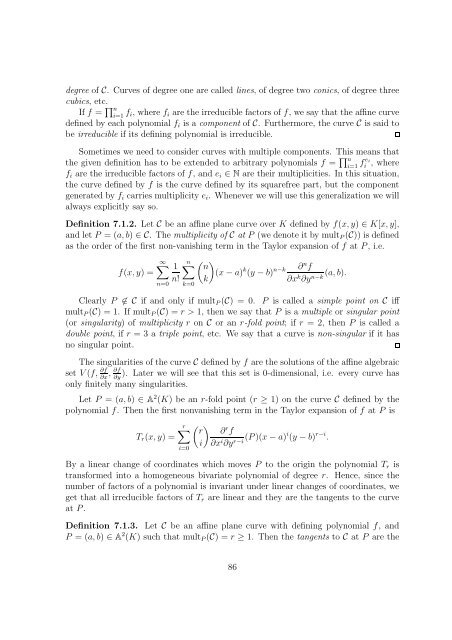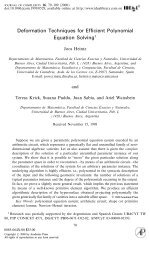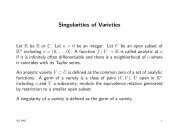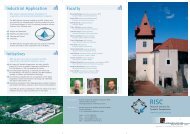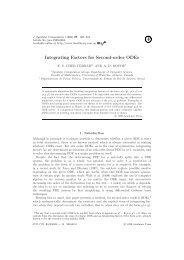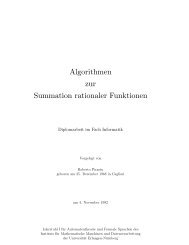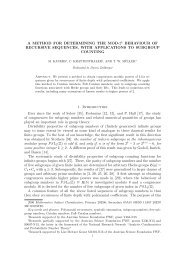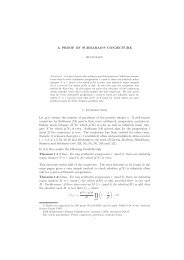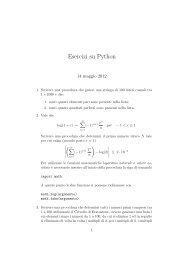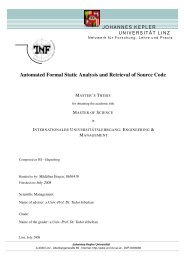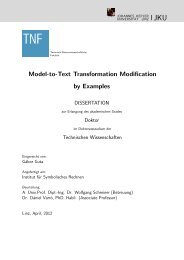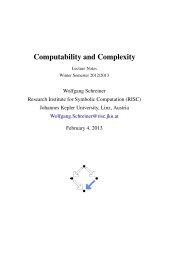Chapter 7 Local properties of plane algebraic curves - RISC
Chapter 7 Local properties of plane algebraic curves - RISC
Chapter 7 Local properties of plane algebraic curves - RISC
Create successful ePaper yourself
Turn your PDF publications into a flip-book with our unique Google optimized e-Paper software.
degree <strong>of</strong> C. Curves <strong>of</strong> degree one are called lines, <strong>of</strong> degree two conics, <strong>of</strong> degree three<br />
cubics, etc.<br />
If f = ∏ n<br />
i=1 f i, where f i are the irreducible factors <strong>of</strong> f, we say that the affine curve<br />
defined by each polynomial f i is a component <strong>of</strong> C. Furthermore, the curve C is said to<br />
be irreducible if its defining polynomial is irreducible.<br />
Sometimes we need to consider <strong>curves</strong> with multiple components. This means that<br />
the given definition has to be extended to arbitrary polynomials f = ∏ n<br />
i=1 fe i<br />
i , where<br />
f i are the irreducible factors <strong>of</strong> f, and e i ∈ N are their multiplicities. In this situation,<br />
the curve defined by f is the curve defined by its squarefree part, but the component<br />
generated by f i carries multiplicity e i . Whenever we will use this generalization we will<br />
always explicitly say so.<br />
Definition 7.1.2. Let C be an affine <strong>plane</strong> curve over K defined by f(x, y) ∈ K[x, y],<br />
and let P = (a, b) ∈ C. The multiplicity <strong>of</strong> C at P (we denote it by mult P (C)) is defined<br />
as the order <strong>of</strong> the first non-vanishing term in the Taylor expansion <strong>of</strong> f at P, i.e.<br />
f(x, y) =<br />
∞∑<br />
n=0<br />
1<br />
n!<br />
n∑<br />
( n<br />
(x − a)<br />
k)<br />
k (y − b) n−k ∂ n f<br />
(a, b).<br />
∂x k ∂yn−k k=0<br />
Clearly P ∉ C if and only if mult P (C) = 0. P is called a simple point on C iff<br />
mult P (C) = 1. If mult P (C) = r > 1, then we say that P is a multiple or singular point<br />
(or singularity) <strong>of</strong> multiplicity r on C or an r-fold point; if r = 2, then P is called a<br />
double point, if r = 3 a triple point, etc. We say that a curve is non-singular if it has<br />
no singular point.<br />
The singularities <strong>of</strong> the curve C defined by f are the solutions <strong>of</strong> the affine <strong>algebraic</strong><br />
set V (f, ∂f , ∂f ). Later we will see that this set is 0-dimensional, i.e. every curve has<br />
∂x ∂y<br />
only finitely many singularities.<br />
Let P = (a, b) ∈ A 2 (K) be an r-fold point (r ≥ 1) on the curve C defined by the<br />
polynomial f. Then the first nonvanishing term in the Taylor expansion <strong>of</strong> f at P is<br />
T r (x, y) =<br />
r∑<br />
( ) r ∂ r f<br />
i ∂x i ∂y r−i(P)(x − a)i (y − b) r−i .<br />
i=0<br />
By a linear change <strong>of</strong> coordinates which moves P to the origin the polynomial T r is<br />
transformed into a homogeneous bivariate polynomial <strong>of</strong> degree r. Hence, since the<br />
number <strong>of</strong> factors <strong>of</strong> a polynomial is invariant under linear changes <strong>of</strong> coordinates, we<br />
get that all irreducible factors <strong>of</strong> T r are linear and they are the tangents to the curve<br />
at P.<br />
Definition 7.1.3. Let C be an affine <strong>plane</strong> curve with defining polynomial f, and<br />
P = (a, b) ∈ A 2 (K) such that mult P (C) = r ≥ 1. Then the tangents to C at P are the<br />
86


